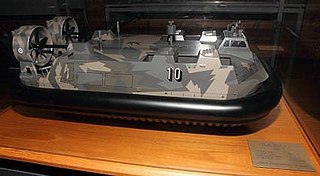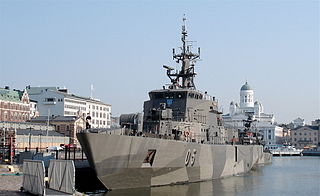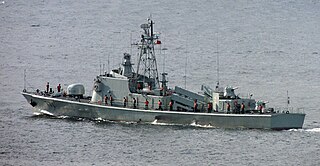
The Royal Danish Navy is the sea-based branch of the Danish Defence force. The RDN is mainly responsible for maritime defence and maintaining the sovereignty of Danish territorial waters. Other tasks include surveillance, search and rescue, icebreaking, oil spill recovery and prevention as well as contributions to international tasks and forces.

The Finnish Navy is one of the branches of the Finnish Defence Forces. The navy employs 2,300 people and about 4,300 conscripts are trained each year. Finnish Navy vessels are given the ship prefix "FNS", short for "Finnish Navy ship", but this is not used in Finnish language contexts. The Finnish Navy also includes coastal forces and coastal artillery.

The Soviet designation Project 1241 Molniya are a class of Russian missile corvettes. They have the NATO reporting name Tarantul. These ships were designed to replace the Project 205M Tsunami missile cutter.

The Croatian Navy is a branch of the Croatian Armed Forces. It was formed in 1991 from what Croatian forces managed to capture from the Yugoslav Navy during the breakup of Yugoslavia and Croatian War of Independence. In addition to mobile coastal missile launchers, today it operates 30 vessels, divided into the Navy Flotilla for traditional naval duties, and the Croatian Coast Guard. Five missile boats form the Croatian fleet's main offensive capability.

Pohjanmaa is a former minelayer of the Finnish Navy. The sole member of her class, she was the flagship of the Finnish Navy as well as the largest naval ship in service in Finland until 2013. The ship has a Finnish-Swedish ice class 1A so she can operate all year round. During a crisis, the main task for Pohjanmaa would have been mine laying and acting as a command ship. She also acted as a school ship for the Naval Academy cadets. Part of their training includes an annual cruise abroad.

The Hamina-class missile boat is a class of fast attack craft of the Finnish Navy. They are classified as "missile fast attack craft" or ohjusvene, literally "missile boat" in Finnish. The Hamina FACs are based at Upinniemi, and form the 7th Surface Warfare Squadron, part of the Finnish Coastal Fleet, together with the minelayers MLC Hämeenmaa, Porkkala and Pyhäranta.

Tuuli was a hovercraft built for the Finnish Navy. Originally intended to be the lead vessel of a class of four combat hovercraft, she was never officially commissioned and after having been laid up for the most of her career, she was broken up in 2013.

The Hämeenmaa-class minelayers is a two-vessel strong class of coastal minelayers, used by the Finnish Navy.

The Estonian Navy are the unified naval forces among the Estonian Defence Forces.

The Vidar-class minelayers consists of the two ships, HNoMS Vidar and HNoMS Vale built by Mjellem & Karlsen in Bergen for the Royal Norwegian Navy in 1977 and 1978. Used as multi-role ships, the Vidar class were tasked with minelaying, personnel/cargo transport, fisheries protection, torpedo-recovery ships and as anti-submarine warfare escorts in Norwegian service. In 2003, Vale was transferred to the Latvian Navy via donation and renamed Virsaitis and used as a flagship and tender to patrol craft. In 2006, Vidar was transferred to the Lithuanian Navy and renamed Jotvingis and served as flagship and tender to mine countermeasures craft. Both vessels had their ASW equipment removed upon transfer.

The Type 037 corvette is a series 400–500 ton corvette type classes in service with the People's Liberation Army Navy. Unlike western navies, the People's Liberation Army Navy does not have dedicated patrol boats in its inventory. Instead, a large variety of corvette type classes, in the form of missile boats and submarine chasers fulfill the tasks of patrolling China's territorial waters. The Egyptian Navy operates eight vessels.

The Project 205 Moskit (mosquito) more commonly known by their NATO reporting name Osa, are a class of missile boats developed for the Soviet Navy in the late 1950s. Until 1962 this was classified as a large torpedo boat.

The Pansio-class minelayers are a three-strong class of mine warfare vessels used by the Finnish Navy, built between 1991 and 1992. The vessels can also be used for transport or to supply the naval forts. The vessels can carry a 100-ton load.

Riilahti was a Ruotsinsalmi class minelayer of the Finnish Navy. Riilahti was commissioned in 1940 and sunk in 1943. The vessel was named after the battle of Riilahti, which was fought between Sweden and Russia in 1714.

The Matka class is the NATO reporting name for a group of hydrofoil missile boats built for the Soviet Navy. The Soviet designation was Project 206MR Vikhr. Following the 1997 Black Sea Fleet partition treaty all Black Sea Fleet Matka class boats were passed to the Ukrainian Navy

The Končar class is a class of six missile boats built for the Yugoslav Navy during the late 1970s at Tito's Shipyard Kraljevica, SR Croatia. The boats featured a mixture of Western and Eastern European equipment, including Soviet anti-ship missiles and Swedish guns.

Sisu was a Finnish state-owned icebreaker. Built in 1939 at Wärtsilä Hietalahti Shipyard in Helsinki, she was one of the world's first diesel-electric icebreakers. In addition to icebreaking duties, she served as a submarine tender for the Finnish Navy during the summer months until the end of the Continuation War.

Pyhäranta is a Finnish Pansio-class minelayer that was commissioned in 1992. The ship underwent an extensive mid-life refit in 2017, but ran aground and damaged its hull during an exercise in August 2022. At that time, it was based at Upinniemi and was a part of the 7th Surface Warfare Squadron of the Finnish Coastal Fleet along with the other minelayers Hämeenmaa and Porkkala, as well as several Hamina-class fast attack craft.

















